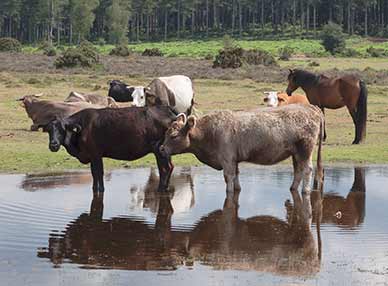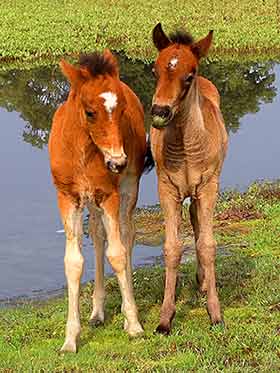Common of Pasture

Common of Pasture is the most widely used New Forest common right - in return for payment of a modest annual ‘marking fee’, those whose land is associated with the common right known as Common of Pasture can turn out ponies, cattle, donkeys and mules on the open lands of the New Forest.
And the benefit of Common of Pasture? It enables commoners, the owners of the stock, to run larger herds of animals than would otherwise be possible were they to depend solely upon their own land.
Although relatively few commoners now make a full-time living from commoning, Common of Pasture is a highly regarded common right - the sale of ponies and beef cattle often makes an important contribution to family incomes, although some commoners put out animals simply to help maintain the age-old traditional ways of life.
Numbers of Common of Pasture stock vary annually. In 2006, for example, 4,204 ponies were put out, 2,572 cattle and 110 donkeys; whilst in 2003, for example, numbers were 3,477, 1,762 and 69, respectively. Mules are rarely seen.
But not only New Forest Ponies are put out, as other breeds are also frequently seen - tiny Shetland ponies are perhaps the most noticeable.
To protect and improve the quality of the New Forest breed, only mares have unrestricted access to the open New Forest, whilst stallions are specially vetted, and allowed out for a limited period each year. Colts are similarly controlled - they must be removed as soon as they are able to breed.
Left to fend for themselves for much of the time, ponies and donkeys must find their own food, water and shelter, although a duty of care rests with owners who must ensure that animals in poor condition are taken off the New Forest. Cattle, though, particularly in harsh, winter weather, are frequently provided with supplementary food, whilst some are also regularly taken back onto commoners’ holdings.
Sadly, road traffic accidents are a regular hazard of life for the animals. Despite 40 mph speed restrictions throughout much of the area, between one and two ponies each week are often killed, and smaller numbers of cattle, donkeys and pigs, many in night-time hit-and-run accidents.
Fluorescent collars for the ponies have in recent years had some effect, but have clearly not completely solved the problem.

near Hatchet Pond
The role of the Agister
Five agisters police the system, each responsible for their own area of the New Forest. Appointed and employed by the New Forest Verderers, the agisters supervise the welfare of the stock, ensure that stock pounds are in good order, attend road traffic accidents, and take action should commoners’ animals be in poor condition – the agisters can insist upon removal from the New Forest.
Pony drifts
Agisters also organise the annual, late-summer and autumn pony round-ups, or drifts. When caught, the ponies are tail-marked to denote the area to which they belong - a different pattern is used by each agister – and also to prove payment by the commoner of the annual charge, the ‘marking fee’.
If necessary, at this time, animals are branded, wormed, generally given a health check-over, and often have fluorescent collars fitted or adjusted. Foals are sometimes removed from their mothers for weaning and some animals are taken off the New Forest altogether – either because they are in poor condition or, more likely, for sale.
Sales
Sales take place from May to November at the sales yard, close to Beaulieu Road station – the ponies are much in demand for riding by children, and adults, a purpose for which they are ideally suited.
Animal Emergency Hotlines
If there is a road traffic accident involving a pony, cow, donkey, pig, sheep, dog or deer you should phone the police on 999 (emergency) or 0845 045 4545 (non-emergency).
If you need to report a sick, injured or distressed pony, cow, donkey, pig or sheep, then you should call the Verderers' Office on 023 8028 2052 during office hours (Mon-Fri 9am-5pm).
Outside of these hours, call the Forestry Commission on 023 8028 3141 (24 hrs).
September 2016 - free wallet-sized cards containing these details can be picked up from Lyndhurst Community Centre and other locations around the area, along with free 'I go slow for ponies' car stickers.
References:
New Forest Ponies: Valerie Russell
A Wild Heritage – The History and Nature of the New Forest: Terry Heathcote
Verderers of the New Forest
More links
Search this site

Sadly, 58 animals were killed - 35 ponies, 13 cows, 8 donkeys and 2 sheep, whilst a further 32 were injured - 3 pigs, 9 donkeys, 11 cows and 9 ponies.
(Forty-three accidents occurred in daylight, 15 at twilight and 101 in the dark. Twenty-seven accidents were not reported by the driver involved).
Here's just one horrific example - Three donkeys killed in collision with van at notorious New Forest blackspot (Advertiser and Times)
Honeysuckle, an early harbinger of spring, shows signs of new growth.
Bird sounds, great tit calls and mistle thrush song, for example, are increasingly heard as the days lengthen and spring rapidly approaches.
Foxes breed during the early months of the year. Their presence is betrayed by barks after darkness falls.
February
Great grey shrikes hunt over heathland from tree-top vantage points and other perches.
Grey squirrels are often best seen in winter when deciduous trees are devoid of leaves.
Red Admirals and other butterflies that over-winter as adults may be on the wing on warm, bright days.
Roe deer antlers continue to develop - they are cast and re-grown annually.

